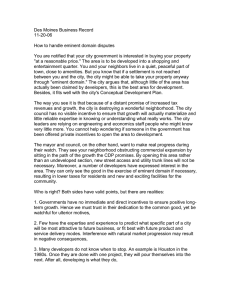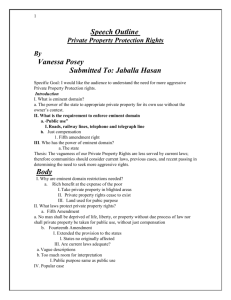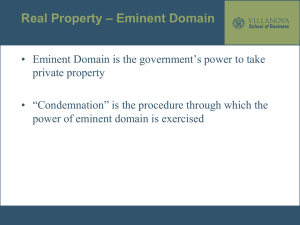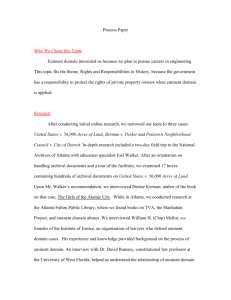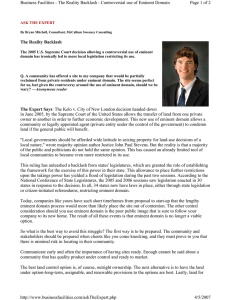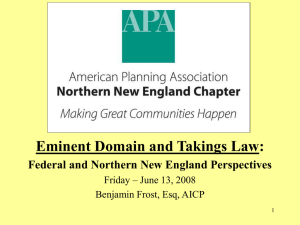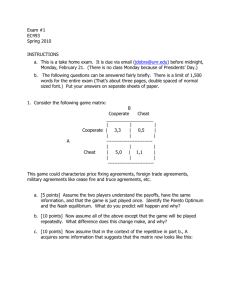NOTE Takings Care of Business: Using Eminent Domain for Solely Economic Development Purposes
advertisement
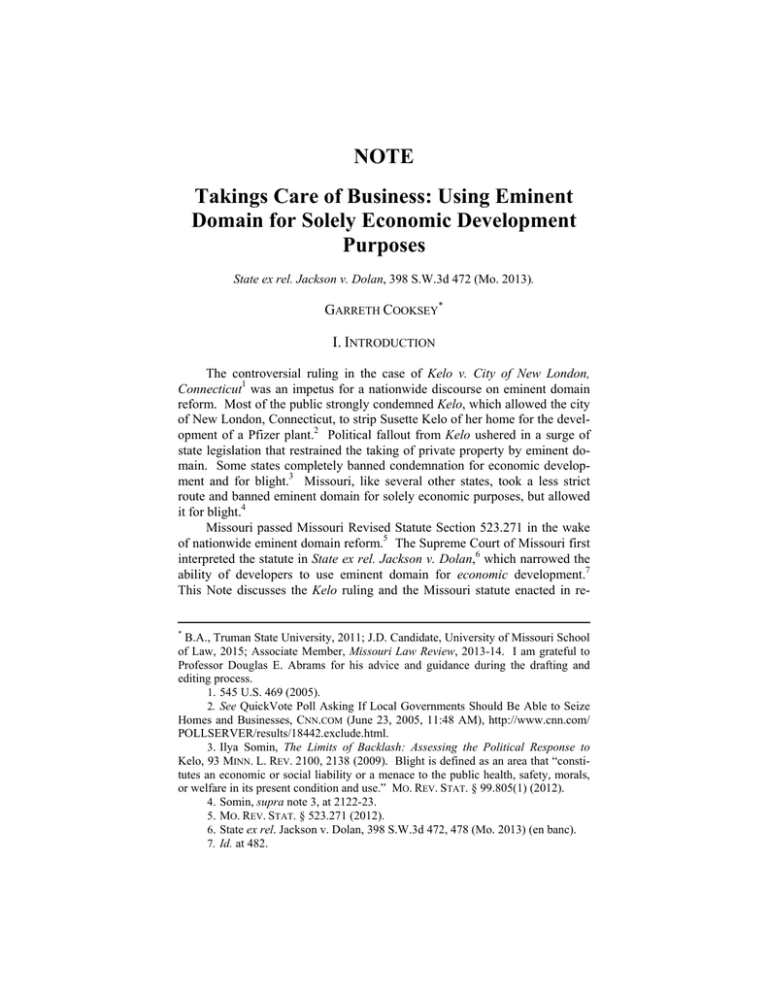
NOTE Takings Care of Business: Using Eminent Domain for Solely Economic Development Purposes State ex rel. Jackson v. Dolan, 398 S.W.3d 472 (Mo. 2013). GARRETH COOKSEY* I. INTRODUCTION The controversial ruling in the case of Kelo v. City of New London, Connecticut1 was an impetus for a nationwide discourse on eminent domain reform. Most of the public strongly condemned Kelo, which allowed the city of New London, Connecticut, to strip Susette Kelo of her home for the development of a Pfizer plant.2 Political fallout from Kelo ushered in a surge of state legislation that restrained the taking of private property by eminent domain. Some states completely banned condemnation for economic development and for blight.3 Missouri, like several other states, took a less strict route and banned eminent domain for solely economic purposes, but allowed it for blight.4 Missouri passed Missouri Revised Statute Section 523.271 in the wake of nationwide eminent domain reform.5 The Supreme Court of Missouri first interpreted the statute in State ex rel. Jackson v. Dolan,6 which narrowed the ability of developers to use eminent domain for economic development.7 This Note discusses the Kelo ruling and the Missouri statute enacted in re* B.A., Truman State University, 2011; J.D. Candidate, University of Missouri School of Law, 2015; Associate Member, Missouri Law Review, 2013-14. I am grateful to Professor Douglas E. Abrams for his advice and guidance during the drafting and editing process. 1. 545 U.S. 469 (2005). 2. See QuickVote Poll Asking If Local Governments Should Be Able to Seize Homes and Businesses, CNN.COM (June 23, 2005, 11:48 AM), http://www.cnn.com/ POLLSERVER/results/18442.exclude.html. 3. Ilya Somin, The Limits of Backlash: Assessing the Political Response to Kelo, 93 MINN. L. REV. 2100, 2138 (2009). Blight is defined as an area that “constitutes an economic or social liability or a menace to the public health, safety, morals, or welfare in its present condition and use.” MO. REV. STAT. § 99.805(1) (2012). 4. Somin, supra note 3, at 2122-23. 5. MO. REV. STAT. § 523.271 (2012). 6. State ex rel. Jackson v. Dolan, 398 S.W.3d 472, 478 (Mo. 2013) (en banc). 7. Id. at 482. 716 MISSOURI LAW REVIEW [Vol. 79 sponse to it. It further examines the beneficial and detrimental implications that Jackson will have on property rights and the economy in Missouri. II. FACTS AND HOLDING In Jackson, Southeast Missouri Regional Port Authority (the “Port Authority”) sought to purchase a 30.65 acre parcel of undeveloped land owned by Velma Jackson and Alicia Seabaugh as trustees.8 The Port Authority viewed the parcel as the foundation for a planned development project in the area.9 Unfortunately for the Port Authority, the trustees were not willing to part with the land.10 Because the trustees were unwilling to sell the parcel, the Port Authority attempted to acquire the land through a powerful statutory vehicle: eminent domain.11 The Port Authority is one of fourteen public port authorities in the State of Missouri.12 The fourteen port authorities are scattered along the Missouri and Mississippi Rivers and function “similar[ly] to Industrial Parks and Economic Development Commissions.”13 Each port authority is involved with the transfer of cargo and storage, as well as the development of the port district that it controls.14 The specific development projects that a port authority undertakes vary from port authority to port authority.15 Due to their public nature, all the port authorities are organized under Missouri Revised Statutes Chapter 68 as a political subdivision of the State of Missouri.16 As such, the State has vested in the port authorities the power to acquire property by eminent domain.17 In Jackson, the 30.65-acre parcel of land in dispute is located in Scott County, Missouri and is bordered by land that the Port Authority owns.18 The Port Authority operates its port district along the Mississippi River and owns between 500 to 600 acres of land in that district, which includes both Scott 8. 9. 10. 11. 12. Id. at 473. Id. at 475. Id. at 473. Id. at 474. MATTHEW B. MCMICHAEL, MO. DEP’T OF TRANSP., UPDATE OF MISSOURI PORT AUTHORITY ASSESSMENT 3 (Nov. 2007), available at http://www.google.com/ url?sa=t&rct=j&q=&esrc=s&source=web&cd=1&ved=0CB8QFjAA&url=http%3A% 2F%2Flibrary.modot.mo.gov%2FRDT%2Freports%2FRi07027%2For08007.pdf&ei= 6WjYU7uQFeGr8gHg3YGIDQ&usg=AFQjCNGc3CsrhNJ18ndBaJAF6B24h54QUg &sig2=eBxS1oAaiyOJaS23_dKxBQ&bvm=bv.71778758,d.b2.U. 13. Id. 14. See Welcome to Our Waterways!, MO. PORT AUTHS., http://www.missouriports.org (last visited July 15, 2014). 15. MCMICHAEL, supra note 12. 16. Jackson, 398 S.W.3d at 474. 17. Id. 18. Id. 2014] TAKINGS CARE OF BUSINESS 717 County and Cape Girardeau County.19 It earns income from two main sources: the leasing of land to tenants and the operation of a six-mile railroad that allows businesses to transfer freight between trains and barges at the harbor.20 In this case, the Port Authority wanted to expand its facilities by building a loop track that could handle unit trains.21 Unit trains are longer trains, around 100 cars in length, that can carry oil and other cargo.22 The current track was ill-equipped to handle trains of this size, and the Port Authority hoped that by building a new loop track it would reduce freight rates and increase the business and employment in the area.23 The Port Authority did not intend to build the loop track on the 30.65acre parcel in dispute.24 It already owned the land where the track was to be constructed but lacked the funding to complete the project.25 To fund the track, the Port Authority sought to condemn the trustees’ land and lease it to private parties.26 One private party had already committed to a lease and desired to build a tank on the land to hold liquid products, such as oil, until the liquid could be loaded onto barges and sent down the Mississippi River.27 The Port Authority had several other potential lessees who aspired to build dry storage units for cargo on the land.28 Parties that did lease the land from the Port Authority would receive the income they made from other businesses using their tanks and dry storage units.29 In return, the parties would help pay for constructing the loop track.30 The trustees argued that since the land was being leased to private parties, those parties will be the only beneficiaries of the land and, thus, there was no public purpose for the taking.31 This, the trustees claimed, was a clear violation of Missouri Revised Statutes Section 523.271 and Article I, Section 28 of the Missouri Constitution.32 The Port Authority argued that leasing the land to private entities would help raise money for the loop track, which would in turn bring jobs to the area and increase commerce in the port dis- 19. 20. 21. 22. Id. Id. at 474- 75. Id. at 475. Id.; Associated Press, Court Blocks Eminent Domain by Port Authority for Land Along Mississippi River, COLUMBIA DAILY TRIBUNE (May 29, 2013, 2:00PM), http://www.columbiatribune.com/news/court-blocks-eminent-domain-by-portauthority-for-land-along/article_1380011c-c87f-11e2-9e7b-10604b9f6eda.html. 23. Jackson, 398 S.W.3d at 475. 24. Id. 25. Id. 26. Id. 27. Id.; see Associated Press, supra note 22. 28. Jackson, 398 S.W.3d at 475. 29. Id. 30. Id. 31. Id. at 476. 32. Id. at 473. 718 MISSOURI LAW REVIEW [Vol. 79 trict.33 Therefore, the Port Authority believed the economic development served a public purpose.34 The circuit court ruled that the taking did not violate Section 523.271 or Article I, Section 28 of the Missouri Constitution.35 The court reasoned that in addition to economic development, leasing the property would help fund the loop track, which would help improve river commerce.36 Because the economic development would primarily benefit the public, the seizure of the property was for a public purpose and the benefit private parties received from the seizure was secondary to the public purpose.37 Following the circuit court ruling, the trustees petitioned the Supreme Court of Missouri for a writ of prohibition.38 The court issued the writ and ruled in favor of the trustees to make the writ permanent.39 The court held that although the Missouri Constitution does not prohibit takings solely for economic development, the legislature enacted a statute that prohibited this kind of taking.40 Before this case, Missouri Revised Statutes Section 523.271 had never been interpreted by the Supreme Court of Missouri or the Court of Appeals.41 The Supreme Court stated that under the statute, the Port Authority must prove “its taking is not solely for economic development purposes.”42 The Port Authority must do this by proving that the purpose of the taking is not “solely to provide an increase in the tax base, tax revenues, employment, [or] general economic health.”43 The Port Authority argued that construction of the loop track was a purpose separate from the economic development.44 However, the court disagreed and ruled that the purpose of the construction of the loop track was for economic development.45 Therefore, the court, by its ruling in Jackson, established that when a government entity in Missouri wants to use eminent domain for economic development, the entity must have a clear non-economic purpose in addition to economic development rationales.46 33. 34. 35. 36. 37. 38. 39. 40. 41. 42. 43. 44. 45. 46. Id. at 478. Id. Id. at 473-74. Id. at 473. Id. at 473-74. Id. at 474. Id. Id. at 478. Id. Id. at 479. Id. Id. Id. at 481. Id. at 481-82. 2014] TAKINGS CARE OF BUSINESS 719 III. LEGAL BACKGROUND This Part analyzes eminent domain in two subsections. First, this Part examines how the U.S. Constitution and the Supreme Court of the United States have dealt with eminent domain, highlighting the controversial case of Kelo v. City of New London. This Part then discusses Missouri’s eminent domain statute, which was enacted in response to Kelo. A. The Constitution, the Supreme Court, and Eminent Domain Eminent domain in the United States began in colonial America.47 The system was borrowed from Britain, where land could be seized for public use.48 Public use in colonial America included such projects as the building of dams and roads.49 Many of the states in colonial America did not provide any compensation for the land seized, rationalizing that “property right[s] could be compromised in order to advance the common good.”50 The founders, realizing both the importance of eminent domain and the importance of private property, balanced these goals in the Fifth Amendment.51 The Fifth Amendment codified the government’s authority to take property, but it also required the landowner to receive just compensation.52 The Takings Clause of the Fifth Amendment to the Constitution states, “[N]or shall private property be taken for public use without just compensation.”53 The term “just compensation” has been fairly easy to define and is generally accepted as the “fair market value of the property at the time of the taking.”54 The term “public use,” on the other hand, has been more difficult to decipher.55 It has been interpreted broadly to give the government the ability to advance the public good, but it also grants the government the discretion to rein in misuses of eminent domain.56 This broad interpretation of public use is what led to Kelo v. City of New London.57 Kelo involved a development plan in New London, Connecticut, in 2000.58 New London was a very poor town with an unemployment rate close 47. Elisabeth Sperow, The Kelo Legacy: Political Accountability, Not Legislation, Is the Cure, 38 MCGEORGE L. REV. 405, 407 (2007). 48. Id. 49. Id. 50. William Michael Treanor, Note, The Origins and Original Significance of the Just Compensation Clause of the Fifth Amendment, 94 YALE L.J. 694, 695 (1985). 51. See Sperow, supra note 47, at 407-08. 52. See id. 53. U.S. CONST. amend. V. 54. Sperow, supra note 47, at 408. 55. See id. 56. Id. at 406. 57. Id. at 405. 58. Kelo v. City of New London, Conn., 545 U.S. 469, 472 (2005). 720 MISSOURI LAW REVIEW [Vol. 79 to double that of the state.59 The population of the town was the lowest it had been since 1920.60 Due to these conditions, local and state officials targeted New London for economic revitalization.61 The State approved a $5.35 million bond issue to fund a development plan by a nonprofit entity, New London Development Corporation (“NLDC”).62 In February of 2000, the pharmaceutical company Pfizer Inc. announced plans to build a $300 million research facility in New London that local authorities hoped would help revitalize the city by generating business in the area.63 The development plan was approved by the city council and was projected to create over 1,000 jobs and to increase tax revenue.64 The city council selected NLDC to implement the development plan in a ninety-acre area.65 It also gave NLDC authority to acquire property by either negotiating a purchase price of the property with the owner or, if that failed, using eminent domain.66 Most property in the area was purchased from owners after negotiation.67 Where negotiation failed, the NLDC ordered the property to be condemned, which resulted in the Kelo lawsuit.68 The petitioners’ property in this case was condemned due to its location in the development area, not because it was in poor condition or blighted.69 The petitioners sued under the Fifth Amendment claiming that the taking of their property was not for a “public use” because private entities would receive the transfer of the property.70 They further argued that eminent domain should not be used for economic development because it becomes difficult to distinguish between the benefits of public and private parties.71 The U.S. Supreme Court disagreed, holding, 5-4, that New London’s development plan served a “public use.”72 The Court wrote that precedent had interpreted the word “public use” more broadly as “public purpose.”73 It stated that even though economic development may benefit private entities, a taking is still an acceptable public purpose where it adds new jobs and increases the tax revenue.74 Yet, the Court did not preclude state legislatures 59. 60. 61. 62. 63. 64. 65. 66. 67. 68. 69. 70. 71. 72. 73. 74. Id. at 473. Id. Id. Id. Id. Id. at 472, 475. Id. at 475. Id. Id. Id. Id. Id. Id. at 485. Id. at 490. Id. at 480. Id. at 483-84. 2014] TAKINGS CARE OF BUSINESS 721 from further restricting the use of eminent domain.75 The democratic process still allows individuals to vote for representatives who will limit takings in their state. Kelo merely held that economic development fulfills the Fifth Amendment’s “public use” requirement and, therefore, land can be seized for that purpose.76 Kelo has had a small number of public supporters who claim that a few property owners may be hurt, but that the Supreme Court decision will ultimately help the residents of the community by increasing employment and tax revenue.77 The depressing result of Kelo was that Pfizer did not go through with its project, and New London’s overall economic development plan never came to fruition.78 Political parties from both sides of the spectrum decried the result.79 In one CNN poll, 66% of a 177,987 respondents said that local governments should never be able to seize property, even for public use.80 Across the nation, citizens were denouncing Kelo as the government overstepping its bounds.81 Following the ruling in Kelo, state legislatures rushed to approve legislation that would curtail eminent domain in their states.82 As of 2009, forty-three states had enacted legislation in response to Kelo.83 The statutes vary in their effectiveness84 and can be separated into several categories.85 Overall, Kelo propelled states to reevaluate 75. Id. at 489. 76. Id. at 490. 77. Editorial, The Limits of Property Rights, N.Y. TIMES (June 24, 2005), http:// www.nytimes.com/2005/06/24/opinion/24fri1.html?_r=0. 78. Katie Nelson, Conn. Land Taken from Homeowners Still Undeveloped, SEATTLE TIMES (Sept. 25, 2009 2:31 AM), http://seattletimes.com/html/nationworld/ 2009939321_apuseminentdomain.html. 79. Somin, supra note 3, at 2108. 80. QuickVote Poll, supra note 2. 81. Somin, supra note 3, at 2108-09. 82. Id. at 2115-20. 83. Id. at 2102. 84. See 50 State Report Card Tracking Eminent Domain Reform Legislation Since Kelo, CASTLE COALITION (Aug. 2007), http://www.castlecoalition.org/pdf/ publications/report_card/50_State_Report.pdf. The Castle Coalition evaluated the “quality and strength of reforms passed in the states” and gave each state a grade from “A” to “F” based on the laws in effect in 2007. Id. at 4. The Coalition gave Missouri a grade of “D.” Id. at 29. 85. Eminent Domain Overview, NAT’L CONFERENCE OF STATE LEGISLATURES, http://www.ncsl.org/research/environment-and-natural-resources/eminent-domainoverview.aspx (last visited June 8, 2014). The National Conference of State Legislatures categorizes the enacted state statutes into five different categories: (1) those that “restrict[] the use of eminent domain for economic development, enhancing tax revenue or transferring private property to another private entity (or primarily for those purposes)”; (2) those that “[d]efine[] what constitutes public use”; (3) those that “[e]stablish[] additional criteria for designating areas subject to eminent domain”; (4) those that “[s]trengthen[] public notice, public hearing and landowner negotiation 722 MISSOURI LAW REVIEW [Vol. 79 their own eminent domain laws and to make changes that would reflect what the people of their state desired.86 B. Missouri Eminent Domain Regarding eminent domain, the Missouri Constitution states: [t]hat private property shall not be taken for private use with or without compensation, unless by consent of the owner, except for private ways of necessity, and except for drains and ditches across the lands of others for agricultural and sanitary purposes, in the manner prescribed by law; and that when an attempt is made to take private property for a use alleged to be public, the question whether the contemplated use be public shall be judicially determined without regard to any legislative declaration that the use is public.87 Before Kelo, Missouri courts had interpreted the “public use” portion of the Missouri Constitution similarly to the Supreme Court’s interpretation in Kelo.88 Before Kelo, Missouri courts had construed “public use” to mean “public benefit.”89 For example, in 1998, a Missouri appellate court held that eminent domain that benefits private entities is constitutional “so long as the primary benefit is to the public.”90 The media throughout Missouri responded to the Kelo decision with hostility. The St. Louis Post-Dispatch, Kansas City Star, and Columbia Tribune all lambasted the ruling.91 Missouri, like many of the states, began to feel pressure from its citizens to reform eminent domain law.92 Five days after Kelo, Missouri Governor Matt Blunt organized a bipartisan task force to tackle eminent domain reform.93 The task force compiled suggestions, listened to witnesses of past condemnation actions, and wrote recommendations criteria, and requir[e] local government approval before condemning property”; and (5) those that “[r]equir[e] compensation at greater than fair market value.” Id. 86. Richard A. Posner, The Supreme Court, 2004 Term: Foreword: A Political Court, 119 HARV. L. REV. 31, 98 (2005). Judge Posner states that the Kelo decision is pragmatic because “[w]hen the Court declines to invalidate an unpopular government power, it tosses the issue back into the democratic arena,” and “opponents of a broad interpretation of ‘public use’ . . . will have to roll up their sleeves and fight the battle in Congress and state legislatures.” Id. 87. MO. CONST. art. I, § 28. 88. Stanley A. Leasure & Carol J. Miller, Eminent Domain – Missouri’s Response to Kelo, 63 J. MO. B. 178, 182 (2007). 89. Id. 90. City of Kan. City v. Hon, 972 S.W.2d 407, 414 (Mo. Ct. App. 1998). 91. Dale A. Whitman, Eminent Domain Reform in Missouri: A Legislative Memoir, 71 MO. L. REV. 721, 727 (2006). 92. Id. 93. Id. at 727-28. 2014] TAKINGS CARE OF BUSINESS 723 about what should be incorporated in the bill.94 A proposed bill incorporated many of the task force’s recommendations.95 Although there was much public outcry following Kelo, many senators felt that being connected with the bill was politically risky.96 The provisions that favored individual property rights seemed to upset the governments in the major cities of the state, as well as real estate developers.97 However, despite reservations and after significant modification, House Bill 1444 was enacted into law.98 An essential section of this legislation is Section 523.271.99 A provision of Section 523.271 states that “[n]o condemning authority shall acquire private property through the process of eminent domain for solely economic development purposes.”100 This provision was the legislature’s specific response to Kelo and bans eminent domain when a condemning authority has only an economic development purpose.101 Section 523.271 also defines economic development for the first time.102 “Economic Development,” under the statute, is defined as the “use of a specific piece of property or properties which would provide an increase in the tax base, tax revenues, employment, and general economic health.”103 The intent of this language was to narrow the situations in which condemning authorities may take property.104 The reception of Missouri’s legislation on eminent domain has been mixed. Specific aspects of the legislation that are viewed as strong in protecting property rights include its definition of “fair market value”105 and the requirement that 125% of that value be paid to homeowners.106 Also, the 94. Id. at 728-29. 95. Id. at 731. 96. Id. at 732. 97. Id. 98. Id. at 721, 733. 99. Id. at 737 n.83. 100. MO. REV. STAT. § 523.271 (2012). 101. Whitman, supra note 91, at 737. 102. Id. at 740. 103. § 523.271. 104. State ex rel. Jackson v. Dolan, 398 S.W.3d 472, 482 (Mo. 2013) (en banc). 105. Whitman, supra note 91, at 764. Fair market value is defined as: the value of the property taken after considering comparable sales in the area, capitalization of income, and replacement cost less depreciation, singularly or in combination, as appropriate, and additionally considering the value of the property based upon its highest and best use, using generally accepted appraisal practices. If less than the entire property is taken, fair market value shall mean the difference between the fair market value of the entire property immediately prior to the taking and the fair market value of the remaining or burdened property immediately after the taking. MO. REV. STAT. § 523.001(1) (2012). 106. Whitman, supra note 91, at 764. Under the legislation, just compensation for the condemnation of a homeowner’s property is “an amount equivalent to the fair market value of such property multiplied by one hundred twenty-five percent.” MO. REV. STAT. § 523.039(2) (2012). 724 MISSOURI LAW REVIEW [Vol. 79 statute’s prohibition of eminent domain solely for economic development and its protection of farmers from blight takings are viewed favorably.107 Yet, critics denounce the legislation as a minor change that in reality does not accomplish much.108 They highlight the government’s continued ability to seize property for private use and the failure of the statute to sufficiently limit blight takings as examples of areas that still need improvement.109 The critics view Florida’s legislation, which bans all takings for private benefit, as a model that Missouri should look to for eminent domain reform.110 IV. INSTANT DECISION In the instant case, the Supreme Court of Missouri found that the loop track was included in the economic development plan, and thus the Port Authority did not have a purpose separate from economic development.111 The court analyzed Section 523.271, which defines “economic development” as an increase in the following four factors: “tax base, tax revenues, employment, and general economic health.”112 To prove that the taking was not solely for economic development purposes, the court stated that the Port Authority would need to have proven that one of the four factors listed above would not increase.113 Instead of trying to prove that one of the four factors would not increase, the Port Authority argued that the construction of the loop track was a separate purpose from the economic development.114 The circuit court agreed with the Port Authority and found two purposes separate from economic development.115 The circuit court stated: 1) that the building of the loop track was a purpose separate from economic development, and 2) that improving river commerce was also a separate purpose.116 The Supreme Court of Missouri did not agree with the circuit court that building the loop track was a purpose separate from economic development.117 The court stated that the Port Authority’s desire to “promote growth in jobs and commerce through additional rail facilities” established that the track was built for economic development under the definition in Section 107. Timothy B. Lee, Property Rights Still in Danger a Year After Kelo, SHOWME INSTITUTE (June 23, 2006), http://www.showmeinstitute.org/publications/commentary/corporate-welfare/298-property-rights-still-in-danger-a-year-after-kelo.html. 108. 50 State Report Card, supra note 84, at 29. 109. Id. 110. Lee, supra note 107. 111. State ex rel. Jackson v. Dolan, 398 S.W.3d 472, 481-82 (Mo. 2013) (en banc). 112. Id. at 479; MO. REV. STAT. § 523.271 (2012) (emphasis added). 113. Jackson, 398 S.W.3d at 479. 114. Id. 115. Id. at 479-80. 116. Id. 117. Id. at 482-83. 2014] TAKINGS CARE OF BUSINESS 725 523.271.118 Because the purpose for constructing the loop track was solely for economic development, the Port Authority violated Section 523.271.119 The court reasoned that if the loop track was considered separate from the economic development, that outcome would allow “any integral part of an economic development plan or project to be considered as a purpose that is separate and distinct from economic development.”120 This reading would be an easy loophole for future development projects to exploit and thus “render the statute a nullity.” 121 The court also disagreed with the circuit court’s finding that improving river commerce was a separate purpose from economic development.122 The court stated that the Port Authority’s taking will only improve river commerce by bringing economic development into the area.123 River commerce, in this situation, will only be improved by the increase in employment and business that results from the economic development in the port district.124 Hence, river commerce and the economic development in this case are intertwined. The court listed examples of ways to improve river commerce that would be separate from economic development.125 Such examples include “dredging the river or building canals to allow for better barge access.”126 The court acknowledged that Section 523.271 might make economic development takings more challenging because it may be difficult for condemning authorities to establish a separate purpose.127 V. COMMENT The Supreme Court of Missouri’s ruling in Jackson narrows the government’s ability to acquire land by eminent domain. Now, a solely economic rationale will not suffice for future takings in Missouri. This ruling has both positive and negative ramifications, as well as an implication on how future property may be acquired by eminent domain. A. Positive Consequences of Eminent Domain Despite the fervent hostility towards eminent domain, it does serve an important purpose in our economy. There are certain situations when emi- 118. 119. 120. 121. 122. 123. 124. 125. 126. 127. Id. at 481. Id. at 481-82. Id. at 482. Id. Id. Id. Id. Id. Id. Id. 726 MISSOURI LAW REVIEW [Vol. 79 nent domain should be used for the betterment of the community.128 Responsible uses of eminent domain include acquiring land for affordable housing and improving deteriorating neighborhoods.129 Existing highways, railroads, and canals, from which people derive benefits daily, could not have been built without eminent domain.130 A New York developer who specialized in urban housing stated that “[t]o do any kind of urban redevelopment without eminent domain is to eliminate half of the potential sites for redevelopment.”131 The result in Kelo has clouded many minds to the fact that there are success stories when eminent domain is used responsibly, even for solely economic development purposes. There are times when eminent domain can provide an entire community with jobs and tax revenue.132 An example is Village West in Kansas City, Kansas.133 Here, 146 homes and four businesses occupied a 400-acre area.134 Eminent domain was needed to acquire the property of just two landowners who refused to sell their property for the development of the area.135 As a result of the property acquisition, retail and entertainment businesses now occupy the land, boosting the local economy.136 Village West has become the largest tourist attraction in Kansas.137 In 2006, the Village West area brought in nine million visitors to its thirty-eight businesses and employed close to 3,500 people.138 Eminent domain was instrumental in the area’s economic growth. Without the use of eminent domain, there is a possibility that the two holdouts could have prevented the development of the area. In essence, two paltry property holdouts out of over 140 properties could have stood in the way of the creation of 3,500 jobs and yearly property tax revenue of around $6 million for the city.139 This situation demonstrates that eminent domain can 128. Editorial, Responsible Use of Eminent Domain, N.Y. TIMES (June 26, 2006), http://www.nytimes.com/2006/06/26/opinion/26mon3.html. 129. Id. 130. See Charles A. Szypszak, Ten Common Misconceptions About Eminent Domain, POPULAR GOV’T 43 (2009), http://sogpubs.unc.edu//electronicversions/pg/ pgwin09/article4.pdf?. 131. Michael Corkery & Ryan Chittum, Eminent Domain Backlash Threatens Some Projects, CHI. TRIBUNE (Aug. 14, 2005), http://articles.chicagotribune.com/ 2005-08-14/business/0508140435_1_eminent-federal-money-supreme-court. 132. Douglas R. Porter, Eminent Domain: An Important Tool for Community Revitalization, URBAN LAND INST. 10 (2007), http://thejcra.org/jcra_files/File/resources/eminent%20domain.pdf. 133. Id. 134. Id. at 21. 135. Id. 136. Id. 137. Top Regional Developments, THINK KC, http://www.thinkkc.com/NewsEvents/TopDevelopments/TopDevelopments.php (last visited July 9, 2014). 138. Porter, supra note 132. 139. Id. 2014] TAKINGS CARE OF BUSINESS 727 be a useful tool even if used for solely economic development purposes. When used properly, eminent domain has the potential to provide economic opportunities to a community. The ruling in Jackson will very likely stifle some of these potential economic opportunities in the state. Missouri could be at a disadvantage when it comes to attracting jobs compared to other states that allow takings for solely economic development purposes. Jackson lessened the chance that a $20 million port project would advance.140 The court’s interpretation of Missouri Revised Statutes Section 523.271 “made it difficult – if not impossible – for the Port Authority to advance its purposes through the use of eminent domain.”141 Because of the ruling, thirty to forty new jobs will no longer be available in the area.142 This ruling also makes it difficult for all Missouri ports along the Missouri and Mississippi Rivers to expand and grow in the future.143 It is now nearly impossible for any of the port authorities in Missouri to use eminent domain for any purpose.144 This is because Section 68.020 states that the port authorities’ main purpose is to stimulate economic development in the port district.145 It will be difficult for the port authorities to claim that they have a purpose aside from economic development when the statute specifically states that their main purpose is for economic development in their port districts.146 Eminent domain is also very useful for preventing one individual from holding hostage an entire group of property owners who want to sell their land.147 The problem of individuals holding out arises when a property owner knows that his parcel of land is essential to the completion of a project.148 Every other property owner that has land essential to the completion of the project may be willing to sell her land at a reasonable price.149 The one hold140. David A. Lieb, Missouri Court Blocks Eminent Domain by Port Authority, BLOOMBERG BUSINESSWEEK (May 29, 2013), http://www.businessweek.com/ap/201305-29/mo-dot-court-blocks-eminent-domain-by-port-authority. 141. Id. 142. Id. 143. Id. 144. See State ex rel. Jackson v. Dolan, 398 S.W.3d 472, 482 (Mo. 2013) (en banc). 145. Id.; MO. REV. STAT. § 68.020 (2012) (“It shall be the purposes of every port authority to promote the general welfare, to promote development within the port district, to encourage private capital investment by fostering the creation of industrial facilities and industrial parks within the port district and to endeavor to increase the volume of commerce, and to promote the establishment of a foreign trade zone within the port districts.”). 146. Jackson, 398 S.W.3d at 482. 147. Thomas J. Miceli & Kathleen Segerson, A Bargaining Model of Holdouts and Takings 1 (Univ. of Conn. Dep’t of Econ., Working Paper No. 200622, 2006), available at http://digitalcommons.uconn.edu/cgi/viewcontent.cgi?article=1020&context=econ_wpapers. 148. Id. 149. See id. 728 MISSOURI LAW REVIEW [Vol. 79 out, on the other hand, knows the project cannot be completed without her parcel of land and, therefore, she is not willing to settle unless her excessive selling price is met.150 This problem has been characterized as a form of monopoly power and cannot be overcome unless the excessive selling price is met or eminent domain is used.151 Even just the threat of eminent domain is enough to cause many stubborn land owners to negotiate a more reasonable selling price.152 With the result in Jackson, eminent domain cannot be used to prevent a holdout problem unless the land is blighted or there is an additional purpose aside from economic development for seizure.153 Now the valuable tool of threatening eminent domain is useless, and landowners can sit on their property rights as long as they desire, waiting for a government entity to match their inflated prices. A group of property owners willing to sell their land is now at the mercy of an obstinate property owner who is holding out for a premium. Even if a property owner is motivated to keep his land because of its sentimental value, is it reasonable to allow one holdout to prevent forty, twenty, or even five willing property owners from selling their land? There is also the possibility that a landowner may not care about the best interest of the community because he does not reside in Missouri. Hypothetically, under the statute, a person who owns land in Missouri but resides in another state could block an entire development project. This situation would be unfair to the local neighbors who wish to sell their property and to the community which desires the economic surplus the development could provide. B. Negative Ramifications of Eminent Domain Eminent domain is sometimes useful, but there are justifiable reasons to oppose eminent domain and applaud the Jackson ruling. A significant reason eminent domain is so strongly disparaged is because some see it as an overextension of the government’s power to infringe on the free market and individual property rights.154 Opponents believe that eminent domain for economic development is a battle that unfairly pits “private, politically powerful individuals and corporations” against the weaker-situated individual whose property is in jeopardy of being taken.155 To opponents, eminent domain is the government “taking grandma out of her house.”156 150. 151. 152. 153. Id. Id. Id. at 2-3. State ex rel. Jackson v. Dolan, 398 S.W.3d 472, 482-83 (Mo. 2013) (en banc). 154. David A. Dana, Reframing Eminent Domain: Unsupported Advocacy, Ambiguous Economics, and the Case for a New Public Use Test, 32 VT. L. REV. 129, 162-63 (2007). 155. Private Property Rights, INSTITUTE FOR JUSTICE, http://ij.org/cases/privateproperty (last visited Oct. 7, 2013). 156. Corkery & Chittum, supra note 131. 2014] TAKINGS CARE OF BUSINESS 729 Much of the negativity surrounding eminent domain also revolves around the fact that the compensation for the acquired property generally does not consider factors outside the property’s fair market value.157 Relocation expenses and the difficulty of finding an affordable replacement home are not factored into the compensation.158 The subjective value of the property to the resident is also not part of the fair market value.159 Overall, the reasoning behind the disdain for eminent domain is best summarized as a view that “the government sometimes exercises its power of eminent domain in a way that is both inefficient and detrimental to the interests of politically unconnected, vulnerable individuals and groups.”160 Unfortunately, as the result of Kelo proved, the government sometimes is inefficient in its use of eminent domain. There are other occasions, similar to the one in Kelo, where the government has tampered with the free market by using eminent domain, and the results are detrimental. For example, in 1998, the City of Phoenix condemned a non-blighted grocery store and several other small businesses in the hopes of transferring the land to a private developer.161 Eight years later, the city had not found a developer to buy the property, which still remains vacant.162 Another example of government inefficiency is the 1981 case of Poletown Neighborhood Council v. City of Detroit.163 The Michigan Supreme Court ruled that the City of Detroit could use eminent domain to evict 4,200 people from their homes and demolish 140 businesses, six churches, a hospital, and several non-profits.164 The City of Detroit took this action so that General Motors could build an automobile plant that it envisioned would create 6,000 jobs.165 The grim reality is only 2,500 people were employed at the plant and it is estimated that the demolition of the neighborhood for the plant actually resulted in a net loss of jobs.166 The Michigan Supreme Court eventually reversed this case in 2004, but the irreparable damage to the historic neighborhood had already occurred.167 157. Nicole Stelle Garnett, The Neglected Political Economy of Eminent Domain, 105 MICH. L. REV. 101, 106 (2006). 158. Id. 159. Id. at 107-08. 160. Nicole Stelle Garnett, The Public-Use Question As a Takings Problem, 71 GEO. WASH. L. REV. 934, 952 (2003). 161. Redevelopment Wrecks: 20 Failed Projects Involving Eminent Domain Abuse, CASTLE COALITION 13 (June 2006), http://castlecoalition.org/pdf/publications/ Redevelopment%20Wrecks.pdf. 162. Id. 163. Id. at 5 (discussing Poletown Neighborhood Council v. City of Detroit, 410 Mich. 616 (Mich. 1981), overruled by Cnty. of Wayne v. Hathcock, 471 Mich. 445 (Mich. 2004)). 164. Id. 165. Id. at 6. 166. Id. 167. Id. 730 MISSOURI LAW REVIEW [Vol. 79 These cases are just two of many examples where the government has interfered on behalf of the private sector by taking private property, and the result has been less than ideal. The ruling in Jackson will help lessen these types of takings in Missouri by prohibiting eminent domain when the purpose is only for economic development.168 Corporations such as General Motors will not be able to use an “increase in the tax base, tax revenues, employment, and general economic health” as the sole rationale for taking property from a person.169 A purpose will need to be cited in addition to economic development before the government may use eminent domain.170 C. Future Takings in Missouri The ruling in Jackson will have both positive and negative implications for Missouri, but the ruling will also likely affect how future developers attempt to use eminent domain. The Port Authority in Jackson failed to prove that it had a purpose in addition to the purpose of economic development.171 The court’s ruling will probably encourage future developers wishing to use eminent domain to shy away from mentioning economic development. Instead, future parties will probably attempt to use the blight exception in Missouri Revised Statutes Section 523.271 for eminent domain.172 Missouri’s definition of blight is considered by some commentators to be very broad.173 Under Section 99.805, blight is defined as an area that “constitutes an economic or social liability or a menace to the public health, safety, morals, or welfare in its present condition and use.”174 This is an extremely broad definition and it is one of the main reasons that the Missouri Statute is graded a “D” by the Institute for Justice’s property rights activism project: the Castle Coalition.175 Most property can still be taken under the blight exception.176 All it takes is some clever lawyering and an affluent developer for property to be construed under the statute as blighted.177 Cities are still allowed to condemn neighborhoods for developers based on the ambiguous standards of “defective or inadequate street layout, unsanitary or unsafe conditions, deterioration 168. 169. 170. 171. 172. State ex rel. Jackson v. Dolan, 398 S.W.3d 472, 482 (Mo. 2013) (en banc). MO. REV. STAT. § 523.271 (2012). Jackson, 398 S.W.3d at 481. Id. § 523.271. The definition of economic development “does not include the elimination of blighted, substandard, or unsanitary conditions, or conditions rendering the property or its surrounding area a conservation area as defined in [S]ection 99.805.” Id. 173. Somin, supra note 3, at 2124. 174. MO. REV. STAT. § 99.805(a) (2012). 175. 50 State Report Card, supra note 84, at 29. 176. Id. 177. Id. 2014] TAKINGS CARE OF BUSINESS 731 of site improvements, improper subdivision or obsolete platting.”178 Most likely, future government agencies and municipalities will abandon trying to claim their use of eminent domain is for a purpose in addition to economic development, and instead will use the blight exception as a way to obtain the property that they desire. VI. CONCLUSION Eminent domain can be used as a beneficial tool, but its use can also be detrimental. The result in Jackson will protect individual property rights, while also making it nearly impossible for port authorities along the Mississippi and Missouri Rivers to develop and expand their operations. Future development projects that rely solely on economic development purposes may find it more difficult to acquire land through eminent domain without an additional purpose. This difficulty will encourage future developers to label more properties as blighted to attempt to bypass the stringent requirement of economic development takings. Missouri will have to confront these issues eventually; for now though, proponents of property rights can applaud the Supreme Court of Missouri for deciding in their favor when confronted with the issue of using eminent domain for solely economic development purposes. 178. § 99.805(a).
